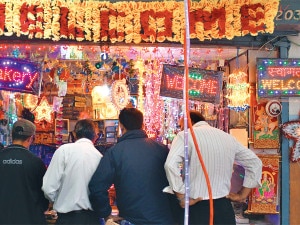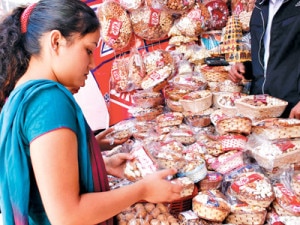Tihar shoppers jampack Capital’s bazaars

KATHMANDU, Nepal- Market areas in the capital city are overcrowded with the shoppers as the Tihar, the festival lights is knocking the doors. The main bazaar areas of Asan, Indrachowk, Mahabouddha and New Road among others are jampacked with Tihar shoppers looking over traditional oil-fed clay lamps, candles, electric lights and of course the dry fruits.
Shops have spilled over on to the street as they don’t have enough room for the extra stock they have brought for the festival. Similarly, pavement stalls selling festival materials are sprawled all over.
Sales of candles and decorative lamps have started to soar with the approach of Tihar , described as the festival of lights. During this holiday, people decorate their homes with rows of lights hoping that the goddess of wealth will bless them with prosperity.
Traders said sales of oil lamps had not been affected despite the arrival of decorative electric lights. “People still believe that lighting candles and oil-fed clay lamps during Tihar will please Goddess Laxmi, the goddess of wealth,” they said.
Tihar, also called as Dipawali, is a five-day-long Hindu and Buddhist festival celebrated in Nepal and India. One day of the festival is celebrated for goddess Laxmi and the other one is celebrated to worship brothers for their long life. However, all ethnic groups celebrate this festival. The festival is celebrated from Trayodashi of Kartik Krishna to Kartik Shukla Dwitiya every year according to the lunar calendar.

The name Tihar means the festival of lights, where many candles are lit both inside and outside the houses to make it bright at night. The five-day festival is considered to be of great importance as it shows reverence to not just the humans and the Gods, but also to the animals like crow, cow and dog, who maintain an intense relationship with the humans. People make things outside of their house, called “Rangoli” in Nepali & Hindi, to make their Home look attractive & beautiful at night.

